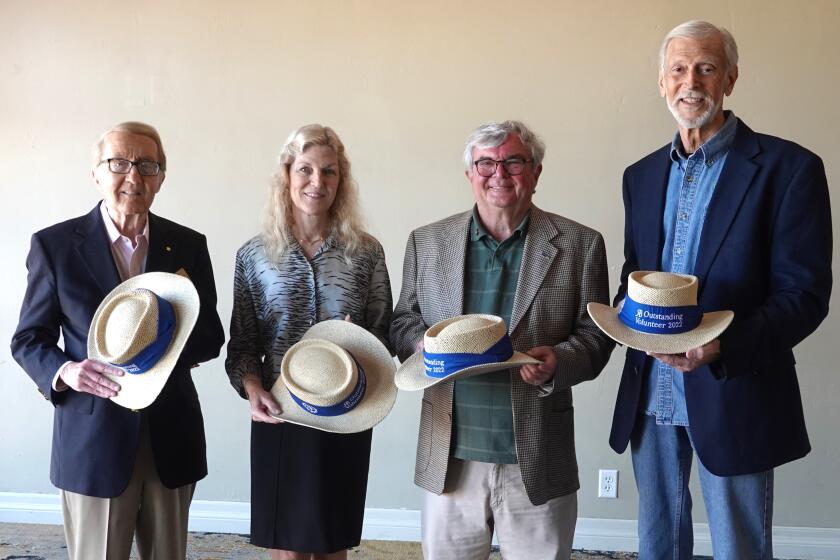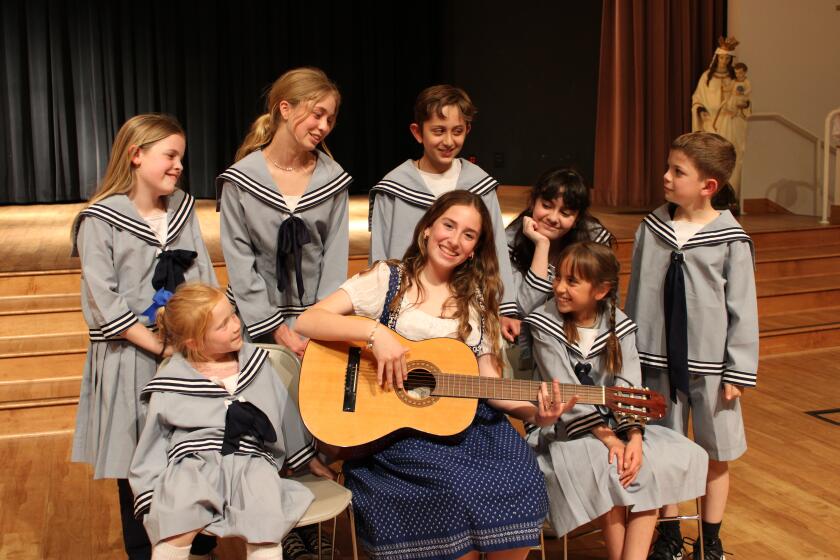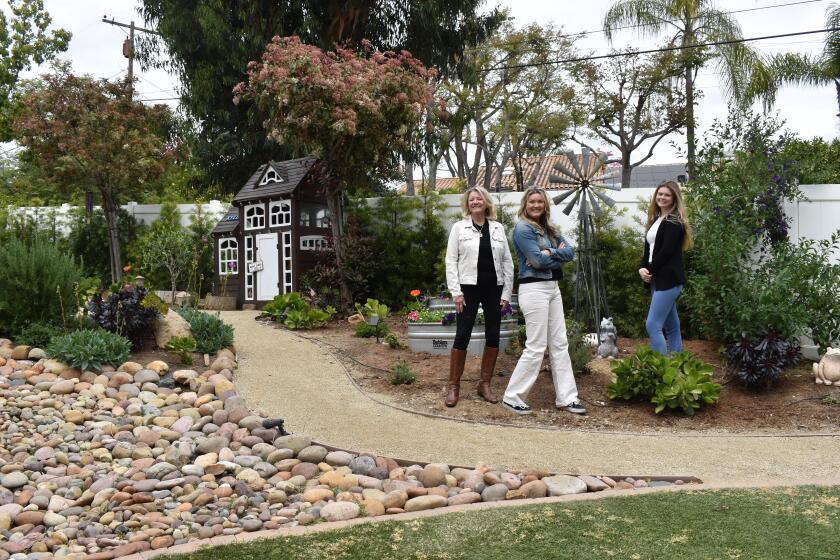Rancho Bernardo’s community centers adapt to the drought
Landscape changes are appearing at some of Rancho Bernardo’s seven community centers as they respond to the region’s four-year drought.
Drivers along West Bernardo Drive are sure to see changes underway since some of the Westwood Club’s more than 40,000 square feet of turf that is being removed and replaced with drought-tolerant vegetation includes the area along the busy roadway.
General Manager Steve Fluss said the project began earlier this month and is likely to be completed by late August. Components include the mulched landscaped front area surrounding the club’s marquee sign, which is also being replaced; retrofitting the irrigation system within the club so it waters in raindrop fashion instead of mist; installing three new smart irrigation weather-controlled timers; and removing 3,000 square feet of turf in the back and replacing it with decomposed granite, which will create a walking path for members that connects with existing sidewalks.
Some projects have been in the works for a while, Fluss said. This included replacing the club’s more than 40-year-old marquee sign that had termite damage. He said the decomposed granite walking path will add a valuable amenity, especially for the club’s seniors who want a safe place to walk in lieu of neighborhood streets. As envisioned, going around the loop roughly three times will equal one mile.
“We’ve been doing a lot in-house over the last three years, when time and money permitted,” he said. “Non-essential turf areas were converted to drough-tolerant and Mediterranean plants. A lot of the areas already established use very little water and we have been continuing to cut water close to four years now.”
The club’s water consumption has decreased significantly on the 13-acre property (at least half is turf), Fluss said. However, while the most recent water bill showed a 37 percent reduction from the same month last year, the cost has not similarly declined because rates continue to rise.
“They’re numbers we can live with,” he said. “We’re trying to keep the essential turf areas, like the picnic areas and baseball fields.”
Even though the club’s board was already moving toward Mediterranean landscaping over the past four years to rejuvenate the property, Fluss said the drought was a catalyst in speeding up the conversion. The club obtained some rebates, covering roughly 20 to 25 percent of the cost. Exact numbers were not available.
Fluss said the goal is to do more, but less dramatic, renovations in other areas of the property over two phases when the club qualifies for more rebates.
As for Rancho Bernardo’s other community centers:
• High Country West General Manager Mike Lutz said the clubhouse area has more than five acres. It also is responsible for 10-plus acres of landscaped common areas and another 20 acres of open space, which is not irrigated. Over the last few years some turf has been removed and re-landscaped with drought-tolerant plants, and its irrigation system was converted to smart controllers.
“We’re looking at a section at a time and getting rebates… which do not cover everything, so we must be prudent,” Lutz said. “We’re using less water and less electricity, which has decreased by 40 percent since we converted to LED lighting and have the air conditioning on a switch.”
With more of the 680 homeowners removing their grass, he said it is important to keep grass at the clubhouse so members can come there to enjoy it.
On a related note, Lutz said the High Country West Homeowners Association is in the process of finalizing its xeriscape guidelines for homeowners wanting to convert turf to less water-consuming options. He said approval applications have gone up by 50 percent and a draft of the guidelines will likely be sent out in a week or two. He said homeowners who let their grass die will not be written up as long as they keep their yards tidy by removing weeds. They do not need to replace their dying grass with something else, but for those who would like to replace it the guidelines will be helpful since there is a minimum of plants required if switching to rock.
• Bernardo Heights General Manager Byron Mettler said the center will continue the process of adding drought-tolerant plants that began a couple years ago. “Now we’re getting plans drawn to do more… but we need to find the funding,” he said, adding it has applied for $15,000 in city rebates and $25,000 in state rebates.
The HOA’s property includes 200,000 square feet of medians — including those on Bernardo Heights Parkway — and Mettler said the goal is to replace some of the grass with drought-tolerant landscaping.
“Our turf is definitely turning yellow and the 4,400 trees on hillsides …like eucalyptus and pines, are stressed due to insufficient watering, making them subject to pests,” he said. “It’s a challenge.”
He said the board looked into utilizing well water, but found the infrastructure needed to distribute well water cost prohibitive since it would have required spending at least $100,000 to install new water lines in the medians.
The HOA has also seen an increase in homeowners filing paperwork so they can convert their yards to drought-tolerant landscaping, Mettler said.
• Oaks North General Manager Rachel Morgan said it is in the process of getting proposals for converting non-visible, unused areas of the five-acre property, and might discuss them in September. There are some drought-tolerant planting areas within the center’s gates and a little grass in the courtyard. Most turf is in the exterior area, she said.
“We have full-time maintenance and a landscaper who really keep a close eye on runoff and watering times,” Morgan said.
• Seven Oaks General Manager Vicki Harvey said the center is trying to get rebates to remove 30,000 square feet of turf throughout the property so drought-tolerant plants and rock can be installed, along with a drip irrigation system to replace its sprayer-style sprinklers.
• The Swim & Tennis Club, Rancho Bernardo’s oldest community center, is in a unique position since it is the only one with access to recycled water, which it obtains from the Rancho Bernardo Inn golf course, said General Manager Wayne Klusmeier. “That’s been going on forever,” he said of the arrangement established roughly 52 years ago.
Because it does not use potable water to irrigate the 10-acre property’s landscaping, it can keep its roses, other vegetation and turf, which include a baseball field, he said. Its waterfall also operates on recycled water.
Even though this means the club is not facing landscaping water cutbacks like the other clubs, Klusmeier said it has still implemented water conservation measures. These include washing the tennis courts with recycled water every six months instead of monthly; washing pool decks once a month instead of weekly (potable water is needed for sanitary reasons); and using water brooms instead of hoses for cleaning, which means 1/8 of the water is utilized. In addition, pools are covered at night throughout the summer to reduce evaporation. Before the drought they were only covered during winter months. Signage has been added to remind members to conserve water when using the showers.
• Eastview representatives did not provide any information by press time, though the board reportedly planned to discuss the topic when it met Tuesday.





